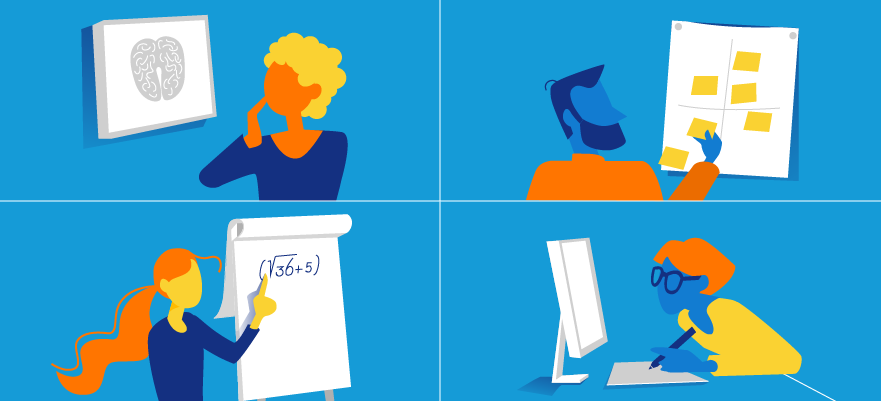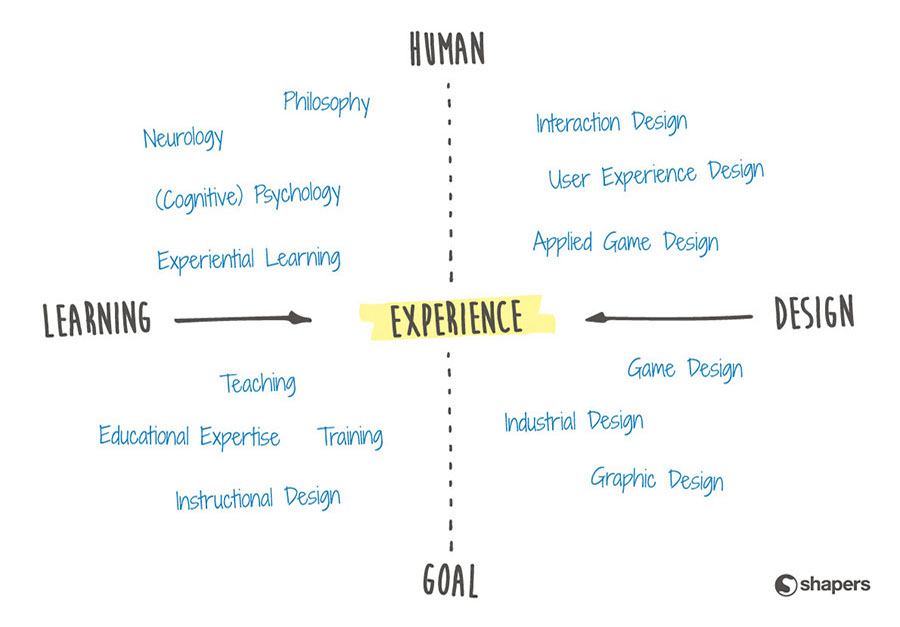The origin of learning experience design
Learning experience design (LX design) is an interdisciplinary design discipline. It incorporates elements of several disciplines from the field of design, like interaction design, user experience design and graphic design with disciplines from the field of learning, like cognitive psychology, neuroscience and instructional design.

The primary roots of LX design lie in the field of design. Design methods, skills and tools have been adapted to focus on creating learning experiences. It has been enriched by methodologies from the field of learning and merged into a new creative design discipline.
To give you an overview of what disciplines are foundational for LX design take a look at this graphic:

Image by N. Floor / Shapers © 2016
In essence, LX design is a combination of two domains: design and learning. However, leaving it at that would be over simplified as both design and learning are broad and diverse domains. That’s why each domain is divided in two parts. This way you end up with four quadrants. Examining these quadrants will offer some valuable insights in the origin and definition of LX Design.
1. Human centered design
The upper right quadrant includes design disciplines that are about human experience. It’s common practice for designers, like user experience designers, to put people at the heart of their designs. This human centered approach enables you to offer an experience that people can relate to and that really works for them. What you design is the actual process people go through. With the options they have, the choices they make, the things that they do and the goals they reach, this is strongly related to what an interaction designer does.
Human-centered design is an approach to problem solving, commonly used in design that develops solutions to problems by involving the human perspective in all steps of the problem-solving process. By focussing on the human perspective in learning it allows learning experience designers to create learning experiences that connect with the learner on a personal, cognitive and emotional level.
2. Goal oriented design
The lower right quadrant is about design disciplines that are focused on creating products that serve a clear purpose. The products we use to facilitate or enhance a learning experience should have both practical and appealing features. Just like an industrial designer designs products that are both functional and beautiful. And like a graphic designer finds creative ways to get a message across in a sophisticated way. Finding the right shape or form for a learning experience is a vital part of designing an effective learning experience.
Goal-oriented design is an interaction design methodology that, according to Alan Cooper "is concerned with satisfying the needs and desires of the users of a product or service." When this methodology is applied to LXD it relates to how products or services used during a learning experience can satisfy the needs and desires of the learner. These needs and desires are primarily, but not exclusively, related to reaching the desired learning outcome.
3. Theory of learning
In the upper left quadrant, you can see more scientific disciplines that are about how people learn. It’s obvious that a LX designer needs to comprehend how human cognition works and how we learn from experience. Combining experiential learning with neuroscientific- and psychological insights is part of the foundation of any good learning experience. There is an interesting link between certain design disciplines, like interaction design, and (cognitive) psychology. As designers they use psychological expertise to understand the people they design for.
4. Learning put into practice
The lower left quadrant is where the actual learning takes place. This is where educational professionals, like teachers and trainers, put the theory of learning into practice. Having both a theoretical and practical understanding of learning is essential. It helps you in designing goal oriented learning experiences that work in a real life situations. Having a clear understanding of what works and what doesn’t work in a specific situation is what educational experts and instructional designers understand.
When designs are created they are often tested. Similar to user testing in user experience design, a learning experience is put to the test with learners going through (parts of) the actual experience. This significantly enhances the chance of your design being successful when put into practice.
Finally
When you put these four pieces of the puzzle together you start to see the whole picture. LX design takes elements from all of these different disciplines and merges them. This list of disciplines is not necessarily all encompassing. It does illustrate the different domains that are elemental to LX design.
Up Next

Learning experience design process
Designing a learning experience can be an unpredictable and adventurous process. This is in a way inherent to the creative, agile and innovative approach LX designers use. Then what does a typical learning experience design process look like?
